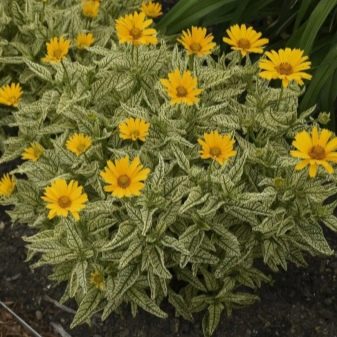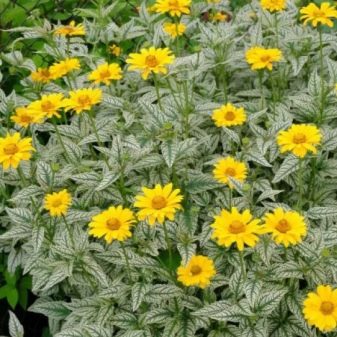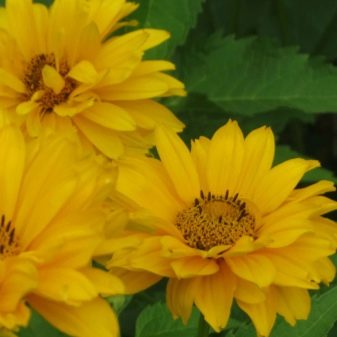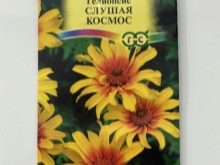Types of variegated heliopsis and its cultivation

Heliopsis variegated is a common perennial plant that is usually grown for ornamental purposes. This flower is very popular with gardeners, as it is famous for its undemanding care and resistance to cold weather. The main advantage of the plant is that it can grow in almost any conditions, which favorably distinguishes it from the background of others. At the same time, heliopsis constantly blooms, giving the site an attractive appearance.

Description
Heliopsis variegated is a herb that belongs to the Aster family. Its distinctive feature is the presence of unique sheet plates, as well as their location. If in most varieties they are dark in color, then here the leaves are quite light and may have small villi. That is why it is quite easy to distinguish heliopsis, since no other plant has such an unusual leaf color. This is due to mutating cells that are unable to produce enough chlorophyll.
Despite the presence of a huge number of shoots, this plant is erect. Most flowers are yellow, but orange or purple buds can also be seen. The shape depends on the type and variety of the plant, because both terry baskets and paniculate inflorescences can be found. Plants begin to bloom in early summer, and the buds bloom right up to late autumn.


Types and varieties
In the process of choosing the most optimal variegated heliopsis for planting in a summer cottage, it is necessary to take into account several important features of the plant. First of all, we are talking about the variety. Today there are a huge number of species of this plant, among which some can be distinguished.
- Variegated. The height of this variety is 90 cm, and there are also many erect stems. The inflorescences in the form of baskets differ in diameter of 10 cm. Such a plant begins to bloom in the summer and continues until the end of autumn. The buds are bright yellow, and the central part can sometimes be orange. Summer residents often use this plant to decorate the local area because of the unique color of the foliage. It is best to plant these varieties in partial shade, thanks to which they will all look more stylish and contrasting. The most prominent of this species is the Lorraine Sunshine variety, which boasts attractive foliage and decorative appearance.


- Terry. This species is distinguished by complex inflorescences, which include a huge number of different petals. Among the typical representatives of this species are such as "summer knight" and "golden feeder". A distinctive feature of this plant is the presence of erect stems, as well as fairly dense foliage. With proper care, the height of heliopsis can reach 120 cm. The plant blooms well even in dimly lit areas, and it can also be planted in partial shade. It is impossible to grow this species in completely shaded areas, since the shoots cannot cope without a sufficient amount of sunlight. This species is famous for its resistance to negative external factors. He is practically not afraid of various pests and rarely attracts them.


- Rough. It is considered one of the most common types. Includes many varieties with double flowers. Among the most famous and popular varieties are such as summer sun, sunburst and golden plum. The main difference between Heliopsis is that it does not need a garter or additional support, which greatly simplifies the growing process. The plant fully blooms in July, and in the middle lane, flowering can continue until the first frost.
Most variegated heliopsis are subdivided into species depending on their height. In landscape design, medium-sized varieties are usually used, which perfectly decorate the local area. The disadvantage of tall options is that they need to be additionally tied up and use special supports. Otherwise, the shoots will begin to break due to the large weight of the inflorescence.

Planting and leaving
In order to ensure the attractive appearance of the plant and its durability, it is necessary to pay close attention to planting in the open field. Despite the fact that the plant is quite unpretentious, the basic rules of planting and growing technology should be observed.
If the cultivation takes place by seedlings, then the seeds should be sown in winters, and the plant can be planted already in May. At the same time, the air temperature should not drop below 10 degrees, even at night. If you plant a plant in summer, then the first flowering, most likely, will appear only next year.
It is best to plant your crop in a flower bed that gets plenty of natural light and has a nutritious soil.


The correct planting of variegated heliopsis involves the implementation of actions in the following sequence:
- the site is cleared of debris and weeds that can harm the plant and prevent it from actively growing;
- dig holes, the depth of which is no more than 40 cm;
- pebbles or expanded clay are poured at the bottom of each hole, after which all this is enhanced by a layer of fertile soil;
- the seedling is placed in the center of the planting pit and covered with soil, after which you can start watering the plant.
The first few weeks after planting, heliopsis should be watered constantly to provide it with the necessary amount of moisture for growth. After the plant has fully taken root, the amount of watering can be reduced to once a week. In the fall, it is necessary to water the culture once every 2 weeks.
Humidification must be carried out at the root without fail to prevent the ingress of water on the foliage, as this can cause the development of infectious diseases.



From the second year, the plant will have to be fertilized with top dressing. An excellent solution for this are various mineral complexes that are designed for flowering crops. If the winter has been too cold, then organic fertilization is best in the spring.
Pruning is also one of the most important steps in plant care. It will be necessary to get rid of dry shoots and leaves in time in order to achieve more lush flowering. In addition, the tops of the plant can be pinched, making the flowers more attractive and vibrant.
Before the first frosts, the bushes must be pruned, removing the shoots to the soil surface, which will allow the plant to survive any weather.

Reproduction
Despite the fact that this plant can be in one place for a long time, its bushes grow very strongly, which leads to the need to carry out division. This breeding method is one of the simplest and most popular. It should be noted that only adult plants that were planted 4 years ago are allowed to be divided.
Perennials must be carefully dug in, and also pulled out of the ground with utmost care. After that, you will have to clear the roots from the soil, as well as the shoots from the embryonic buds.The maternal part returns to its place, and the rest is processed with potassium permanganate and soaked in special growth stimulants for further planting.
Some gardeners also propagate variegated heliopsis with seeds for planting and use stratified material, which is sown in the ground even in winter and covered with loose soil. If the weather is too cold outside, then it is best to cover the plant with a film that will create the effect of a greenhouse.



Diseases and pests
If the leaves of the plant curl and the roots turn yellow, then this may indicate that heliopsis is affected by some kind of disease.
Despite the fact that the culture is distinguished by strong immunity and resistance to many common diseases, it is very often exposed to gray rot and rust. In addition, one of the main problems is powdery mildew, which, if not properly cared for, can completely destroy the plant. That is why it is desirable to carry out preventive measures, which consist in the use of fungicides.
If the disease has already struck the culture, then it is best to use solutions based on copper sulfate or Bordeaux liquid to fight. They perform well in the presence of many diseases. Irrigation is carried out several times a day using a solution of different consistency.
As for pests, heliopsis is very often attacked by aphids. You can get rid of this pest with the help of special insecticides.



Flower in landscape design
The unique features of the plant make it possible to use it for both single and group plantings. The culture is unpretentious in care, so you can use several varieties in one place or combine it with other plants. The variegated heliopsis goes well with asters, gladioli, hydrangeas and chrysanthemums. In the process of creating a monochrome garden, heliopsis is very often used in combination with other plants with a similar color.













































































































The comment was sent successfully.